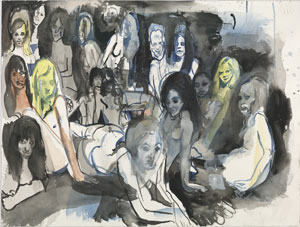11.10.23 — Vanity, vanity
Cecily Brown should have learned her lesson. She has been staring at her reflection in a mirror for thirty years now and seeing only a temptress, a crone, a death mask, or a skull.
She cannot help looking, though, for she is only human. Besides, she is a woman and an artist, and this is a savvy woman’s art, at the Met through December 3. It should have you looking, too, but you will not see anything as dreadful as death. This is painting so lush that it keeps coming back to life. 
Vanity, vanity, all is vanity and a striving after fame and fortune in art. Brown came to New York in the 1990s, with the much hyped Britpack (or Young British Artists), only she chose to stay. I caught her in 2000 as an emerging New York artist at MoMA PS1 (then just P.S.1), again with a growing approach to Abstract Expressionism, and in 2020 with her aspirations to the Old Masters. In between she brought her torments and seductions to the Drawing Center. (I cannot repeat all that here, so by all means follow the links for more.) As a postscript, George Condo, too, takes pride in faking history, at the Morgan Library, but with a greater Postmodernism and a great deal less thought—and I bring this together with my report on Condo as a longer review and my latest upload.
Surely Brown is due for a retrospective, and surely she is the last person to need one. The Met keeps its aspirations modest, in the long central room of its wing for modern art. It can handle just fifty works, about half of them preliminary sketches, but it can make almost anything look like a blockbuster. It does not need a monster of a mural that dominates, for now, the lobby of the Brooklyn Museum with its elusive subject matter and lavish red. It does not even need much in the way of Brown’s development as an artist. She began with lighter backgrounds and sketchier subjects, adding denser subjects and more colorful brushwork, and finally veering toward monochrome, but she is still a woman staring at her reflection while daring you to stare at both.
What you see may depend on you. Will you find the corpse in Blood Water Fruit Corpse—and is that paint blood and water or the thing itself? Will you find corpses everywhere else? Or are they even corpses, for white spirits rising and pink flesh in ambiguous poses close to the floor could be very much alive? You may need a hint to spot a cat hiding under a table, but it has no fear of death. And yet Brown’s titles allude to a long tradition of fearing death in life.
Vanitas long attached to a woman at her mirror, for youth will fade, and fruit are still life—in French dead nature, or nature morte, like Brown’s Lobster, Oysters, Cherries, Pearls. Skulls are momento mori, or remember death. Hers arise as if of their own accord from girls in frilling dresses, for the skull’s eyes and nose, and an arch, for its top. (A smaller scene serves as its mouth.) Rooms for still life have the grandeur and luxury of aristocratic Europe, with other reminders of the past on its walls. A table spread for a picnic could be a banquet or a mad tea party, awaiting Brown in her madness or you.
The show’s title, “Death and the Maid,” positions her as forever between life and death, old and young. So does a brushy painting called BFF. The term is up-to-date, but paint itself (an older artist advised her) will always be her best friend. And that could be her real theme, for all the heavy titles. Still life can morph into interiors, into bodies in an unstated narrative, or abstraction. Painting is like that these days, shifting among genres, but she was among the first in making it so.
The overtones do get in the way. Death and the Maid alludes to Death and the Maiden, the maid bringing flowers in Olympia by Edouard Manet, and (gulp) a woman’s role in the workplace today. A shipwreck with no visible ship may allude, tenuously, to Théodore Géricault—and Willem de Kooning and his women hang over them all. Another still life is after Frans Syders, the Flemish painter, because what still life is not? One might do better to treasure the ambiguity and forget the details. Or treasure a world well lost and the paint.
For all the moralizing, Brown traffics in pleasure. When she riffs on The Battle Between Carnival and Lent, by Pieter Bruegel, she has not made up her mind. The picnic table has an ashtray, because she has any number of bad habits, and she is in no hurry to give them up. But then neither was Snyders. The freshness of this world accounts for his appeal, too. Brown’s art may lie first and foremost in seeing through the excuses to make art.
Read more, now in a feature-length article on this site.